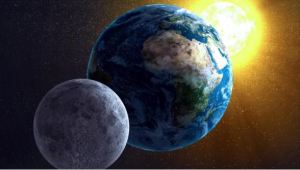There are many reasons NASA is pursuing the Artemis mission to land astronauts on the moon by 2024: It’s a crucial way to study the moon itself and to pave a safe path to Mars, says Phys.org.
But it’s also a great place to learn more about protecting Earth, which is just one part of the larger Sun-Earth system.
Heliophysicists—scientists who study the Sun and its influence on Earth—will also be sending up their own NASA missions as part of Artemis. Their goal is to better understand the complex space environment surrounding our planet, much of which is driven by our Sun.
The more we understand that system, the more we can protect space technology, radio communications, and utility grids from the wrath of our closest star.
Here are five reasons that heliophysicists are over the moon about lunar opportunities.
1. It’s a Steady Satellite
The first advantage of moon-based science concerns satellite jitter, which rattles space scientists of every stripe.
Satellites are shakier than you might think. They’re made of metals that expand and contract with temperature changes. They carry telescopes that constantly pivot to stay pointed at targets. They fire boosters and spin reaction wheels to stay in orbit. Each of these maneuvers causes jitter, which can throw off measurements that demand precision.
But the moon—Earth’s only natural satellite—is a much smoother ride.
“The moon is a nice stable place—it doesn’t shake or jitter like a spacecraft,” said David Sibeck, a heliophysicist at NASA’s Goddard Space Flight Center in Greenbelt, Maryland. “Anyone trying to do high-resolution measurements will be happy to not have to worry about jitter.”
A jitter-free environment is a plus for all space sciences, but there are added bonuses for heliophysicists who study the aurora. At an average of 238,855 miles from Earth, the moon has a great view of Earth’s aurora when they move equatorward during large geomagnetic storms.
In addition, since the same side of the moon always faces Earth, telescopes don’t need to be adjusted nearly as much. Plant them on its surface, and the moon keeps them pointed for you.
2. Prime Eclipse Viewing, On Demand
Long before the space age, scientists relied on the moon to help them study the Sun. Patient observers waited for total solar eclipses, when the moon blocks out the Sun’s bright surface. Only then could they see its tenuous outer atmosphere, known as the corona.
But the waits could be long. A total solar eclipse happens somewhere on Earth once every 18 months. For any specific location, it’s more like once every four centuries.
“We get fantastic results out of eclipses,” said John Cooper, a heliophysicist at Goddard. “But we don’t get them every day.”
But a Sun-watching telescope, in the right sort of orbit around the moon, could generate eclipses “on demand.” Instead of waiting for the moon to move across your telescope’s line of view, Cooper explains, you move your line of view behind the moon.
Continued here.







Reblogged this on Climate- Science.press.
The moon would be a nice place to have a large telescope built much bigger than the Hubble telescope , which would give us a clearer view of the universe.
“The moon is a nice stable place—it doesn’t shake or jitter like a spacecraft,” No, it just rings like a bell and quakes periodically. Still, an observational post or two like Antarctica on the surface is long overdue. I just wonder if Sir Fred Hoyle, were he still with us, would be on board with more space stationed scopes.
Thick fluid dampener mounts would take care of Moon Quakes et. al.
Also, having only 1/6th gravity would make building very large structures (telescopes / mirrors) easier.
The proper time to build a fully functional Moon Base was about 1979. We’re only 40 years late in the game…
a Sun-watching telescope, in the right sort of orbit around the moon
So not on the Moon itself.